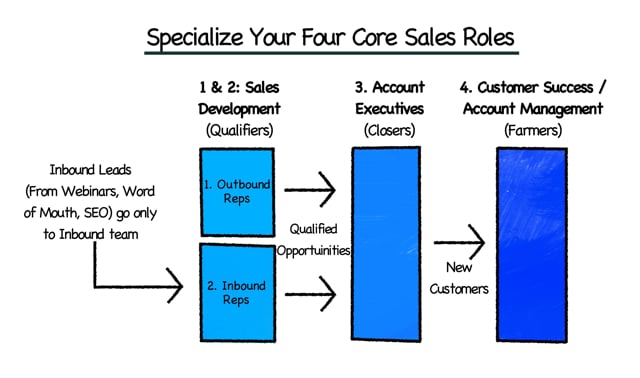


Sales and marketing alignment has been a hot topic for a couple of years now, but is alignment really enough? The idea of taking two organizations with completely different skill sets and missions and fusing them into one sales and marketing machine is nice in theory, but in practice, there are some issues. Is there a better way to build a rockstar sales and marketing team?
Some of the best minds in B2B sales and marketing have tackled this issue and presented viable structures that could possibly work. For example, in his book, Predictable Revenue, Aaron Ross talks about transforming your sales process with a hybrid approach involving low-touch email marketing to find and engage decision makers and influencers and traditional sales calling to qualify and close. David Skok expands on Ross' approach and describes how to break down the sales organization into a new version of the "Hunter," "Closer" and "Farmer" roles by blending inbound marketing in at the top of the sales funnel. Here's a David Skok schematic to show how this might work.

In this structure, both sales and marketing are involved in lead generation (Hunting). Inbound marketers attract new leads with content marketing, SEO, demand generation and social media. Leads are nurtured, scored and passed along to the Closers via marketing automation. Depending on the industry and sales model, the inbound marketing team could also hand off leads to an inside sales team or channel sales reps. In addition, Ross' hybrid outbound telesales/email team identifies and contacts likely buyers at specific target companies and arranges appointments for the closers. Closers do their thing and hand off new accounts to the Farmers for implementation, training, support and, ultimately, retention and upsales.
The Ross/Skok model makes sense if you think about the strengths and weaknesses of your team members:
You probably recognize these skills in your own people, but how many of them are really good at more than one of these roles? For those with multiple strengths, how many of them can efficiently split time between these roles and still accomplish the mission of each one? The most effective companies recruit for these roles and hire them into teams that work together on specific industry or regional verticals, product types or service offerings. Placing functional specialists together on a sales team leverages the best skill sets and experience of each team member and joins them in a common mission devoid of organizational boundaries or competing interests.
The model breaks down when there is no such structure present, when people are assigned to the wrong roles or have too many responsibilities—or when parts of the structure are missing entirely. For example, a company that relies entirely on inbound marketing for lead generation is going to find it difficult to attract buyers (like CEOs) who are too busy to spend much time researching online or companies that already have an entrenched solution (like an internal department) resistant to change. Skilled outbound Hunters may be the only way to gain entry. Relying entirely on outbound marketing may also backfire, since there is no sustainable process for growth from digital sources. Similarly, tasking hunters and qualifiers with closing account sales may not work either, because they may simply lack the skills and comfort level with closing. Saddling Closers with Farming may dilute their efforts in sales calls and cause a significant drop-off in sales growth over time.
You can call these teams whatever you want, maybe it's business development teams or revenue generators and drop the Sales and Marketing titles. The point is each team is a lean functional unit with a common purpose and complementary skills and roles. Without the overhead of Sales and Marketing Managers, they are free to do what they do best and perform beyond expectations. There is no need for SLAs or other top-down communications designed to force them to work together in harmony—they already do that by definition.
Maybe it's time to rethink your organizational structure along functional and synergistic lines rather than departments and skill sets. By working as a team, marketing experts can help sales reps accomplish their goals, because they share the same goals. And sales reps can help marketers get a better handle on how to reach and communicate with buyers. Together they create a team that can perform at a higher level than the sum of the parts.
Photo credit: United States Navy
